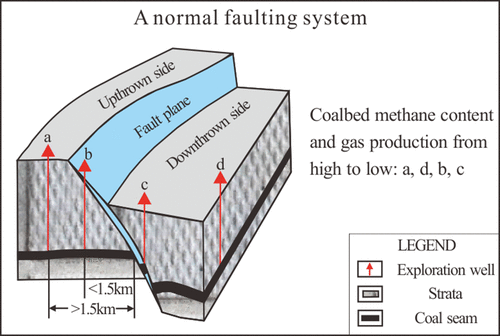当前位置:
X-MOL 学术
›
Energy Fuels
›
论文详情
Our official English website, www.x-mol.net, welcomes your
feedback! (Note: you will need to create a separate account there.)
Fault Development Characteristics and Their Effects on Current Gas Content and Productivity of No. 3 Coal Seam in the Zhengzhuang Field, Southern Qinshui Basin, North China
Energy & Fuels ( IF 5.2 ) Pub Date : 2021-01-22 , DOI: 10.1021/acs.energyfuels.0c04149 Hui Wang 1, 2 , Yanbin Yao 1, 2 , Chencheng Huang 3, 4 , Dameng Liu 1, 2 , Yidong Cai 1, 2
Energy & Fuels ( IF 5.2 ) Pub Date : 2021-01-22 , DOI: 10.1021/acs.energyfuels.0c04149 Hui Wang 1, 2 , Yanbin Yao 1, 2 , Chencheng Huang 3, 4 , Dameng Liu 1, 2 , Yidong Cai 1, 2
Affiliation

|
Faulting is one of the most common geological features that impacts current gas content (CGC) of coal seams, which is an important parameter for coalbed methane (CBM/gas) production. However, the detailed faulting effects on CGC and productivity have not been thoroughly investigated, because of inadequate methods for quantitative evaluation of the effects. In this study, we carry out comprehensive analysis of diverse geological coring data and experimental results and production data of exploration wells as well as the three-dimensional fault interpretation in the Zhengzhuang field. We introduce a parameter fault scale (F) to quantify the scale of faults, which is described by fault length, fault throw, and the investigated area. Then we propose a horizontal grid method to determine the faulting influence on CGC. The relationships between the CGC and the fracture density of coal core, the mechanical properties of the roof and floor of coal seam, the average gas production in a faulting system (including the upthrown side, downthrown side, and fault plain) are analyzed. In the study area, the well-developed normal faults have significant influence on CGC, but the locally developed thrust faults have negligible influence. The square grid with length of 1.5 km is probably the most effective grids for analyzing faulting effected distance on CGC. Thus, the normal faults can be divided into small- (F1.5 < 0.05), moderate- (0.05 < F1.5 < 0.15), and large-scale (F1.5 > 0.15). The evident effect of faulting on CGC can be observed up to ∼1.5 km away from the normal fault. When the coal seam is further away from the normal faults (i.e., >1.5 km), the CGC is higher or closer to 20.7 m3/t. In contrast, when the coal seam is <1.5 km from the normal faults, the CGC decreases with increasing value of F. In general, the CGC is higher on the downthrown side, with better gas preservation conditions than the upthrown side. Relatively high CGC (>20 m3/t) is necessary for good gas production of CBM wells. The CBM wells with low ADGP (<500 m3/d) and low CTGP (<105 m3) are commonly located on the fault plane and upthrown side of normal faults. In general, the places far away (>1.5 km) from the normal faults is the most favorable productivity area, and only the small-scale normal faults developed is the secondary favorable productivity area. These places have the average gas production as high as 1000 m3/d and cumulative total gas production as high as 4 × 105 m3.
中文翻译:

华北沁水盆地郑庄油田三号煤层断层发育特征及其对当前瓦斯含量和产能的影响
断层是影响煤层当前瓦斯含量(CGC)的最常见的地质特征之一,这是煤层气(CBM / gas)生产的重要参数。但是,由于没有足够的量化方法来评估影响CGC和生产率的详细断层效应。在这项研究中,我们对多种地质取芯数据,实验结果和勘探井的生产数据以及郑庄油田的三维断层解释进行了综合分析。我们介绍一个参数故障量表(F)来量化故障的规模,该规模由故障长度,故障引发和调查区域来描述。然后我们提出了一种水平网格方法来确定断层对CGC的影响。分析了CGC与煤芯破裂密度,煤层顶板和底板的力学性能,断层系统(包括上倾侧,下倾侧和断层平原)的平均产气量之间的关系。在研究区,发育良好的正断层对CGC的影响很大,而局部发育的逆冲断层的影响则微不足道。长度为1.5 km的正方形网格可能是分析断层对CGC的影响距离最有效的网格。因此,正常故障可以分为小故障-(F 1.5<0.05),中等(0.05 < F 1.5 <0.15)和大规模(F 1.5 > 0.15)。可以在距正常断层约1.5 km处观察到断层对CGC的明显影响。当煤层远离正常断层(即> 1.5 km)时,CGC会更高或接近20.7 m 3 / t。相反,当煤层距正常断层<1.5 km时,CGC随F值的增加而减小。通常,下翻侧的CGC较高,气体保存条件优于上翻侧。较高的CGC(> 20 m 3 / t)对于CBM井良好的天然气生产是必需的。低ADGP(<500 m 3 / d)和CTGP(<10)的煤层气井5 m 3)通常位于断层平面和正常断层的上升侧。通常,远离正断层的地方(> 1.5 km)是最有利的生产区,只有发育的小规模正断层是次要的有利生产区。这些地方的平均产气量高达1000 m 3 / d,累计总产气量高达4×10 5 m 3。
更新日期:2021-02-04
中文翻译:

华北沁水盆地郑庄油田三号煤层断层发育特征及其对当前瓦斯含量和产能的影响
断层是影响煤层当前瓦斯含量(CGC)的最常见的地质特征之一,这是煤层气(CBM / gas)生产的重要参数。但是,由于没有足够的量化方法来评估影响CGC和生产率的详细断层效应。在这项研究中,我们对多种地质取芯数据,实验结果和勘探井的生产数据以及郑庄油田的三维断层解释进行了综合分析。我们介绍一个参数故障量表(F)来量化故障的规模,该规模由故障长度,故障引发和调查区域来描述。然后我们提出了一种水平网格方法来确定断层对CGC的影响。分析了CGC与煤芯破裂密度,煤层顶板和底板的力学性能,断层系统(包括上倾侧,下倾侧和断层平原)的平均产气量之间的关系。在研究区,发育良好的正断层对CGC的影响很大,而局部发育的逆冲断层的影响则微不足道。长度为1.5 km的正方形网格可能是分析断层对CGC的影响距离最有效的网格。因此,正常故障可以分为小故障-(F 1.5<0.05),中等(0.05 < F 1.5 <0.15)和大规模(F 1.5 > 0.15)。可以在距正常断层约1.5 km处观察到断层对CGC的明显影响。当煤层远离正常断层(即> 1.5 km)时,CGC会更高或接近20.7 m 3 / t。相反,当煤层距正常断层<1.5 km时,CGC随F值的增加而减小。通常,下翻侧的CGC较高,气体保存条件优于上翻侧。较高的CGC(> 20 m 3 / t)对于CBM井良好的天然气生产是必需的。低ADGP(<500 m 3 / d)和CTGP(<10)的煤层气井5 m 3)通常位于断层平面和正常断层的上升侧。通常,远离正断层的地方(> 1.5 km)是最有利的生产区,只有发育的小规模正断层是次要的有利生产区。这些地方的平均产气量高达1000 m 3 / d,累计总产气量高达4×10 5 m 3。











































 京公网安备 11010802027423号
京公网安备 11010802027423号